70th Death Anniversary of Rabindranath Tagore
A unique telling of Muktadhara
 “Muktadhara” (The Waterfall), written in 1922, is widely acclaimed as one of Tagore’s finest dramatic work. The symbolic play has been interpreted as Tagore’s nationalist critique of colonial exploitation. Many believe the play also indicates the bard’s admiration for Gandhi and his rejection of the machine in favour of humanism. The character of Dhananjoy Boiragi has been seen as a reference to Gandhi’s non-violent spirit. Many, however, suggest that the play is far more complex, and deals with Tagore’s interactions with science and the concept of nation.
“Muktadhara” (The Waterfall), written in 1922, is widely acclaimed as one of Tagore’s finest dramatic work. The symbolic play has been interpreted as Tagore’s nationalist critique of colonial exploitation. Many believe the play also indicates the bard’s admiration for Gandhi and his rejection of the machine in favour of humanism. The character of Dhananjoy Boiragi has been seen as a reference to Gandhi’s non-violent spirit. Many, however, suggest that the play is far more complex, and deals with Tagore’s interactions with science and the concept of nation.
Synopsis: Chitrakoot, ruled by the despotic King Ranajit, is dependent for its financial might on Shibtarai. Ranajit attempts to control it by denying the Shibtarai people water. He builds a dam across the waterfall Muktadhara. The play chronicles the hostilities between the denizens of the two states and the non-violent resistance to Ranajit by the enigmatic singer-sage, Dhananjoy Boiragi. Lurking in the background is the mammoth machine built by the royal engineer Bibhuti. The heir to the throne, Abhijit, nurtures a deep attachment with the free flowing Muktadhara. His love for the waterfall and his refusal to allow the King to exploit the people of Shibtarai prompts him to demolish the dam. The force of the waterfall is let loose and in the process Abhijit too is swept away.
The play is still popular and regularly staged by several theatre troupes in Bangladesh. The post-’70s generations might not have heard of it, but many of their predecessors fondly recall, a production of the play that was unlike any other.
This particular production of “Muktadhara” was staged in April 1972, at a Chhatra Union conference in Suhrawardy Udyan, Dhaka. The show was part of a two-day programme presented by Shangskriti Shangshad, according to Abul Hasnat, editor of Kali O Kalam. Hasnat was the president of Shangskriti Shangshad then.
“It was a newly independent country and we had limitations, but despite all that, ‘Muktadhara’ was an outstanding production. Artist Mustafa Monwar pretty much single-handedly brought the play to the stage. The 32×24 ft stage was aesthetically unique. Asaduzzaman Noor, Kazi Tamanna, Golam Rabbani and Abul Hayat played the key roles. Renowned Indian artistes Debabrata Biswas and Suchitra Mitra attended the programme, among many others,” Hasnat recalled.
Mustafa Monwar reminisced: “The set was one of a kind. Since it was an outdoor stage, the ambiance was altogether remarkable; Around 4000 people were in the audience. The highlight was the scene of the dam coming apart. Five/six fire trucks with water were behind the stage to create a mighty torrent. Lights were brought over from FDC. The audience watched in awe.”
Unfortunately, no photo of the play could be found; curiosity remains unquenched. Solution? A reproduction on the same or bigger scale.
-With The Daily Star input




















